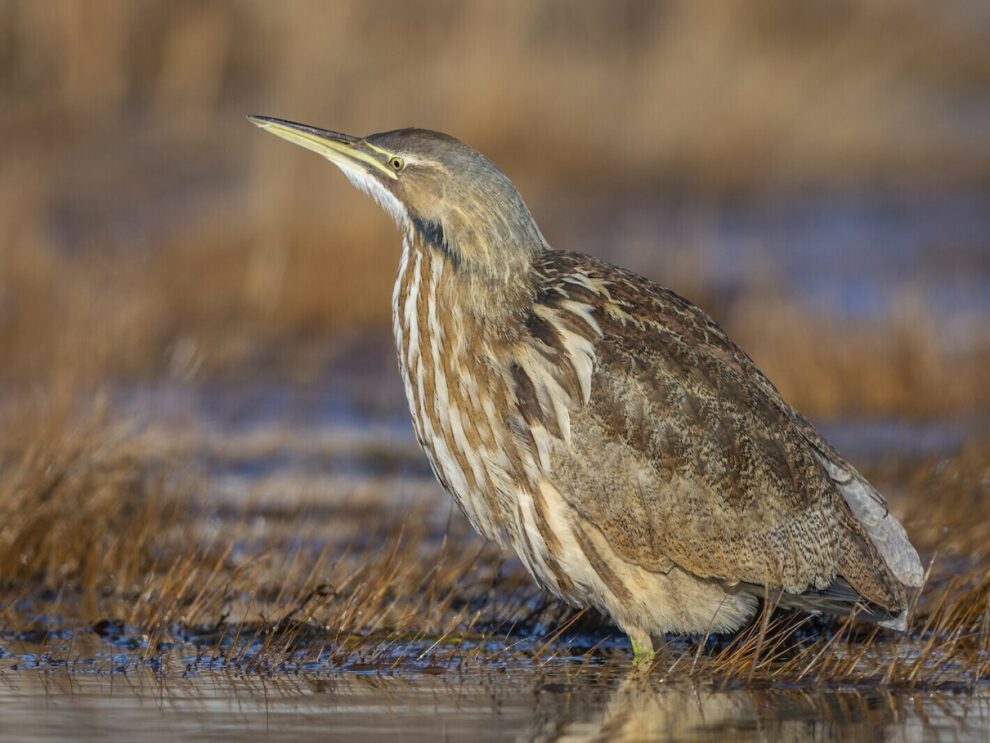September is upon us. It seems like just yesterday we were talking about the return of springtime migrant birds — robins, bluebirds, hummingbirds and many others. Already, the marshes are quiet. Boisterous red-winged and yellow-headed blackbirds have disappeared, black terns are no longer chattering their constant discontent, and the calls of the “slough-pumper” have long ceased. Just a young farm boy, I remember the first time I heard the term slough-pumper used as a name for a bird.
“What a weird name,” I recall thinking. My dad, the dairy farmer he was, spent a good share of his days outdoors and he always had an eye cocked toward the woods and wetlands. A farmer at heart, he’s also an outdoorsman, although in this case he got it wrong; for he’d point to a great blue heron and call it a slough-pumper. Years later, an aspiring young fish and wildlife biologist, ornithologist and all-around naturalist, yours truly, learned the truth. Dad was wrong. The so-called slough-pumper is the American bittern.
Interestingly, I’ve never written a column exclusively about the American bittern. I checked over 30 years of columns and darned if I can find one. I’ve included bitterns in many other columns about secretive birds, bird vocalizations and wetland-dependent birds, but not one column featured the American bittern all by its lonesome. How I overlooked or didn’t consider the American bittern deserving of a column all its own is beyond me, especially given my interest, close encounters and history with the species.
American bitterns are a species of heron. Between a crow and a goose in size, the American bittern is a bird that is more often heard than seen. In fact, it’s rare to even observe a bittern fly let alone see one skulking in emergent wetland vegetation. And its plumage, coupled with its behavior, is quintessential cryptic in every manner, shape, and form. Blacks, browns, buff and white coloration grace the American bittern. Additionally, they are heavily vertically streaked on their breast and necks, making them virtually invisible within the thick coverts of their cattail and upright vegetative environment.
Moreover, the species has the interesting habit of stretching its neck and pointing its beak to the sky to appear exactly like its surroundings. With eyes that are set in such a way, the bird has no difficulty seeing nearly all around itself while standing motionless in their telltale, unusual posture.
But what’s with this slough-pumper name? Alas, there are other endearing and interesting names for the American bittern as well. Depending where geographically across its breeding range throughout most of North America, it’s also called “bog bumper,” “stake driver,” “thunder pumper,” “water belcher,” and “mire drum,” too.
And why? It’s all because of the distinctive vocalization that only this bird makes. To some human ears, the unmistakable breeding call of the male American bittern is not unlike the sound of an old pump. The process of the American bittern vocalization during the spring breeding season is as interesting as the sound itself. The sound is often written out as a resonant “pump-er-lunk” or “onk-a-ronk” call that has a fluid-like quality to it.
To produce the unique sound, the bird inflates its esophagus and gulps air while producing a clicking, hiccuping sound. As the vocalization culminates in the characteristic and recognizable gulping sound, the bird violently tosses its head back with each gulp sound as it opens and closes its bill. After a rest period, the male bittern will vocalize its territorial breeding call once again. A solitary bird, American bitterns spend most of their reclusive lives in hiding. Bashful birds by nature, one can still observe them going about their business from the distance with the aid of binoculars, or close by if the bird believes you don’t see them.
My most memorable American bittern experience occurred while studying secretive species of birds within North Dakota wetlands. Using play-back call techniques with the aid of an electronic game caller, amplifier and a cassette tape of bittern calls, I once attracted a bittern to within mere feet of me as I hid in the tall cattails. I couldn’t believe it when the bird vocalized right before my very eyes — and ears! American bitterns, a secretive species of wild bird they are, is a bird worth knowing, seeing and hearing, as we get out and enjoying the great outdoors.
Source: BEMIDJI PIONEER















